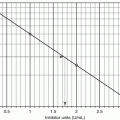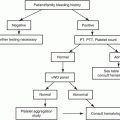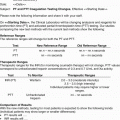Fig. 9.1
Regulation of thrombin activity by vascular endothelium. The effects of major antithrombotic properties of the blood vessel wall are shown. Regulation of thrombin activity is important because thrombin is a major factor in thrombosis (platelet activation, fibrin formation). Abnormalities in regulation of thrombin activity may lead to hypercoagulability and an increased risk of thrombosis. Major antithrombotic properties include: heparin-like glycosaminoglycans (heparan sulfate, HS) on the luminal surface that catalyze antithrombin (AT) inhibition of thrombin, generating inactive thrombin-antithrombin (T-AT) complexes; thrombomodulin (TM), an endothelial cell receptor for thrombin. The thrombin-TM complex converts protein C to APC; protein S (PS) functions as a cofactor binding protein for APC, permitting inactivation of factors Va/VIIIa, resulting in inactivation of coagulation; and endothelial cell secretion of tissue-plasminogen activator (TPA) that initiates fibrinolysis. Most of the coagulation components shown in this figure can be assayed by the laboratory to identify thrombosis risk (From Rodgers [2], with permission)
Antithrombin is a natural anticoagulant that irreversibly binds to and inactivates activated clotting factors such as factor Xa and thrombin. This inactivation is catalyzed by heparin-like glycosaminoglycans on the endothelial cell surface (see Fig. 9.1) or by therapeutic heparin [1].
The fibrinolytic mechanism components include plasminogen, tissue-plasminogen activator (TPA), plasmin, α2 – antiplasmin, and plasminogen activator inhibitor (PAI-1). Fibrinolysis is initiated when vascular thrombosis triggers endothelial cell secretion of TPA. In the presence of TPA, plasminogen is converted to plasmin that degrades fibrin clots. Plasmin activity is regulated by α2 – antiplasmin, while TPA activity is regulated by PAI-1. Either deficiency or excess of these components may occur leading to hypofibrinolysis and a thrombotic risk or hyperfibrinolysis and a bleeding risk [1].
9.2 The Inherited Thrombotic Disorders
Table 9.1 summarizes the inherited thrombotic disorders and describes their prevalence, inheritance patterns, and clinical features. Abnormalities of the protein C pathway (protein C, protein S, factor V Leiden, thrombomodulin) constitute most cases of inherited thrombosis [3]. Most inherited disorders are transmitted in an autosomal dominant manner, and venous thromboembolism is the usual clinical feature. The importance of inherited fibrinolytic disorders (TPA deficiency or excess PAI-1 activity) is uncertain.
Table 9.1
Summary of the inherited thrombotic disorders
Classification and disorders | Inheritance | Estimated prevalencea | Clinical features |
|---|---|---|---|
Deficiency or qualitative abnormalities of inhibitors to activated coagulation factors | |||
AT deficiency | AD | 1 % | Venous thromboembolism (usual and unusual sites), heparin resistance |
TM deficiency | AD | 1–5 % | Venous thrombosis |
Protein C deficiency | AD | 1–5 % | Venous thromboembolism |
Protein S deficiency | AD | 1–5 % | Venous and arterial thromboembolism |
APC resistance due to Factor V Leiden | AD | 20–50 % | Venous thromboembolism |
Abnormality of coagulation zymogen or cofactor | |||
Prothrombin mutation | AD | 5–10 % | Venous thromboembolism |
Elevated factor VIII | Unknown | 20–25 % | Venous thromboembolism |
Elevated factor IX | Unknown | ~10 % | Venous thromboembolism |
Elevated factor XI | Unknown | ~10 % | Venous thromboembolism |
Impaired clot lysis | |||
Dysfibrinogenemia | AD | 1–2 % | Venous thrombosis >arterial thrombosis |
Plasminogen deficiency | AD, AR | 1–2 % | Venous thromboembolism |
TPA deficiency | AD | ? | Venous thromboembolism |
Excess PAI-1 activity | AD | ? | Venous thromboembolism and arterial thrombosis |
Metabolic defect | |||
Homocysteinemia | AR | 1 in 300,000 live births; | Arterial and venous thrombosis (homozygous patients); |
10–25 % of patients with recurrent thrombosis | Premature development of coronary and cerebral coronary and cerebral arterial thrombotic disease (heterozygous patients) | ||
Another common inherited thrombotic disorder is the prothrombin gene mutation. This mutation is associated with elevated plasma prothrombin levels, which may explain the predisposition to thrombosis [5].
Homocysteinemia is a metabolic disorder associated with thrombosis. Although pediatric patients present clinically with homozygous homocysteinemia (homocystinuria), adult patients heterozygous for homocysteinemia have primarily premature arterial disease (myocardial infarction, stroke, peripheral vascular disease). Heterozygous homocysteinemia may account for a significant number of patients with arterial vascular disease in the absence of traditional risk factors (e.g., smoking, hypertension, hyperlipidemia). Between 1 and 2 % of the general population have heterozygous homocysteinemia. Homocysteinemia is also associated with venous thromboembolism [6].
A recently described inherited risk factor for thrombosis is elevated levels of factor VIII activity. Although factor VIII is an acute-phase response protein, as many as 10–20 % of patients with recurrent venous thrombosis have elevated factor VIII levels as their only risk factor [3].
Increased levels of other coagulation factors, including fibrinogen, factor IX, and factor XI have also been associated with thrombosis. However, routine laboratory testing of these factors is not recommended by the College of American Pathologists Consensus Conference on Thrombophilia (see Table 9.2).
Table 9.2
Summary of the College of American Pathologists’ recommendations on laboratory testing for inherited thrombosis
Thrombotic disorder | Who should be tested? | Test method(s) | Comments |
|---|---|---|---|
Factor V Leiden | First VTE at age <50 years | APC resistance assay using factor-V deficient plasma or DNA-based assay | Patients with relatives who are known to have FVL should be tested directly with DNA-based assays. Patients with positive APC resistance assays should have confirmatory DNA tests. |
Recurrent VTE | |||
First unprovoked VTE | |||
First VTE, unusual site | |||
First VTE, positive family history | |||
First VTE related to pregnancy or hormonal therapy | |||
Unexplained second or third trimester pregnancy loss | |||
Prothrombin gene mutation | As above | DNA-based assay | Prothrombin activity assays should not be used |
Homocysteinemia | Arterial vascular disease Controversial for VTE | HPLC or immunoassays | Genotyping for MTHFR mutations is not recommended. Fasting may not be necessary. Proper sample processing is necessary. Testing in VTE patients may be appropriate to identify and treat affected patients with vitamins. |
Protein C deficiency | Infants with neonatal purpura fulminans | Chromogenic substrate assays are preferred | Avoid testing during acute thrombosis or anticoagulant therapy. Exclude causes of acquired PC deficiency. Consider age-dependent reference ranges. |
VTE patient from a family with known | |||
PC deficiency | |||
Asymptomatic female from a known | Functional assays are useful | ||
PC-deficient family prior to hormonal therapy | Immunologic assays are discouraged | ||
Protein S deficiency | Patient with VTE from a family with known PS deficiency | Functional assay or Immunoassay for free PS | Abnormal functional assay results should be confirmed with an immunoassay for free PS. Exclude acquired causes of PS deficiency. Avoid testing during acute thrombosis, anticoagulant therapy, and pregnancy. Consider age- and gender-dependent reference ranges. |
Total PS antigen assays not recommended | |||
Antithrombin deficiency | Patient with VTE from a family with known AT deficiency | Chromogenic substrate assays are preferred | Exclude acquired causes of AT deficiency. Avoid testing during acute thrombosis or anticoagulant therapy. |
Asymptomatic female from a known AT-deficient family prior to hormonal therapy | AT antigen assays not recommended | ||
Elevated factor VIII levels | Controversial | Factor VIII activity assay | Test 6 months after thrombosis. Avoid anticoagulant therapy. |
Dysfibrinogenemia | Not recommended | ||
Heparin cofactor II | Not recommended | ||
Factor XIII polymorphisms | Not recommended | ||
Plasminogen activator inhibitor-1 | Not recommended | ||
Plasminogen deficiency | Test in non-DVT patients with ligneous conjunctivitis |
9.3 General Principles of Thrombosis Testing
1.
Laboratory evaluation should be postponed until 2–3 months after the acute thrombotic event when the patient is clinically well and has not received anticoagulant therapy for 2 weeks. Thrombosis induces an acute-phase response that makes interpretation of coagulation-based tests difficult. Reliable data for assays such as antithrombin, protein C, and protein S activities are best obtained in the absence of anticoagulant therapy. If anticoagulants cannot be discontinued in the affected patient, then surrogate testing of symptomatic family members who are not receiving anticoagulants can be done. However, if DNA-based assays (for the factor V Leiden or the prothrombin gene mutations) are performed, these results will not be affected by acute-phase changes of thrombosis or anticoagulant therapy. Similarly, homocysteine testing will not be affected by acute-phase changes or anticoagulant therapy. If factor VIII activity testing is to be done, it should be deferred until 6 months after the thrombotic event [3].
2.
The probability of obtaining positive thrombosis testing results is increased if the patient population being investigated is restricted to young patients (<50 years of age) with recurrent thrombosis or patients with a single event and a positive family history for thrombosis [3].
3.
Functional coagulation assays are recommended over immunologic assays for evaluation of antithrombin, protein C, or protein S deficiencies. Functional assays detect both quantitative deficiency and qualitative abnormality of the protein. On the other hand, functional assays are affected by anticoagulant therapy, and interpretation of abnormal functional assay results must take into account whether the patient is receiving anticoagulants [3].
4.
Assay for common etiologies first (factor V Leiden/APC resistance, prothrombin gene mutation, homocysteinemia) [3].
5.
Heterozygous homocysteinemia should be considered as a cause for thrombosis in middle-aged patients with premature vascular disease as well as a cause of venous thrombosis [3].
9.4 Laboratory Testing Strategy for Inherited Thrombosis
There are two testing strategies for inherited thrombosis-arterial and venous etiologies. Most cases of arterial thrombosis are not inherited, but acquired, including disorders such as diabetes, hyperlipidemia, and other causes of atherosclerosis, plus other etiologies such as vasculitis, myeloproliferative disorders, etc. Inherited etiologies for arterial thrombosis include elevated levels of PAI-1, homocysteinemia, and some patients with protein C or S deficiencies.
Stay updated, free articles. Join our Telegram channel

Full access? Get Clinical Tree






